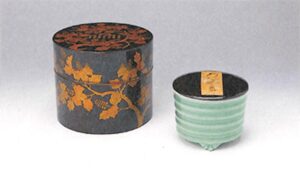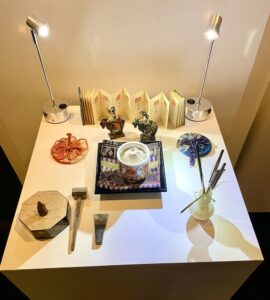
Kodo, “Way of incense” is the art of appreciating Japanese incense, and is counted as one of the three Classical Japanese arts of refinement, along with Kado for flower arrangement, and Sado for tea and the tea ceremony.
Originating in the mid-Muromachi period, the art of “Kodo” overcame the upheavals of the Warring States period and developed in the Edo period, approximately 260 years without war, brought by successive generations of the Tokugawa. During this period, under the patronage of the Tokugawa, Kodo reached maturity as an elegant art form and was prized not only by the warriors, the palace’s ladies of Edo Castle, and the intelligentsia but also by the common people of the city in the mid-Edo period.
Ieyasu Tokugawa, who was the founder and first shogun of the Tokugawa Shogunate of Japan, acquired a large number of agarwood, and he was strongly attracted to the famous “Lanjatai” incense.
Lanjatai is a type of agarwood, a famous fragrant tree came from China in the Nara period (710-794) and has been held as a Shosoin Imperial Treasure.
The Shino School of Kodo is the largest school of “Kodo” in Japan, with a history of 500 years. And this year the Shino School of Kodo held an exhibition at the Zojoji Temple, which is closely associated with the Tokugawa family, to transmit “Kodo”

The fragrant woods used for Kodo are agarwood. They are imported from south-east Asia. The resin of certain trees that have naturally died or decayed by bacteria is deposited in the wood while buried in the soil and emits an aroma when it is heated.
For this reason, the only way to collect fragrant wood is almost entirely by chance. Moreover, deposition can only occur in old trees that are several decades old.
The use of such precious woods makes the general public not familiar with “Kodo”
In the first part of this exhibition, we could see the portraits of Shogun Ieyasu and the masters of the Shino school, a list of Kodo’s effectiveness, and some documents related to “Kodo”.

Then, there is a part for displaying the tools for “Kodo”. The small shelves that hold each tool, the artificial flowers, the cloth and paper that wrap the incense wood, the incense burner, and various others are all beautifully and delicately crafted.
In authentic “Kodo”, there is also a game called “Kumiko”, in which the participants smell the fragrance and try to guess what it is. There is a “Kumiko” tied to “the Tale of Genji”, and its tools are decorated with elegant designs associated with the tale.
In the last part, the most precious 61 incenses, including “Lanjatai”, are displayed. Most of them are wrapped in beautiful paper and classified by origin and taste.
In this exhibition, we can reserve a simple “Kodo” workshop. I recommend you to experience this one.
We went a little nervously into a tatami room behind the exhibition venue. The room is simple, clean, and sacred as the “Kodo” instructor explained that this room usually is used for hospitalizing the emperor or the leaders of Japan.
The instructors are kind, elegant, and very enthusiastic to explain “Kodo”.
Their detailed explanation helped us understand why it is quite rare to know about “Kodo” even though in Japan.
This time we experienced 2 incenses called “Harukaze”(Spring wind) and “Sakazuki”(sake cup). I imagined colorful flowers from feminine “Harukaze” and open fire from masculine “Sakazuki”. Both of them have rich and deep flavors and are so interesting to feel the fragrances were changing over time.
During this workshop, the fragrance gave a very calming and spiritually satisfying experience.
If you would like to taste the traditional Japanese culture, try to find a “Kodo” workshop.